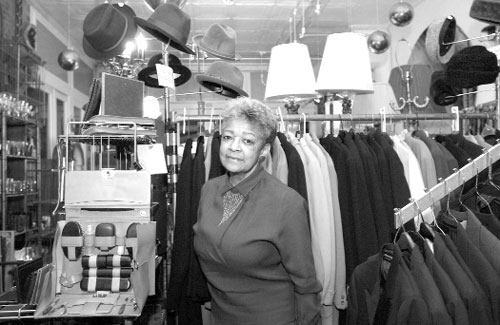By Alison Gregor
While many of us flock to suburban malls or uptown to shop
for the holidays, we may overlook some fine shops right here in our neighborhood.
With many of our local retailers continuing to struggle in the wake of 9/11,
we have decided to spotlight some of them this holiday season.
Whether you’re taking the A train or just in the mood for a bit of nostalgia, you might take shelter in the warm jazzy atmosphere of Jae Jarrell’s ‘Vintage Menswear and Collectibles’ in Tribeca.
Once you climb the stoop and open the door, the jazz music and graciousness of Jae Jarrell envelope you at this unusual store for men, located at 466 Greenwich and Watts, just a few blocks from the train line made famous by jazz artist Billy Strayhorn.
To the uninitiated, the shop might appear eclectic; but Jarrell says there is a method to her madness, which consists of following her own tastes in collecting.
“I wanted to do something where I could establish my own spirit,” explains the former designer and fashion and textile expert. “I wanted to communicate with people who were fond of many memories that I have. There are those people who walk in for the first time and just get it.”
Some of them almost never had the chance. Jarrell had planned to open Sept. 14, 2001, but on the eve of that date, found her store covered in soot and Tribeca closed to traffic. But she did not lose her pluck, even in the face of the neighborhood’s economic woes.
“I came here with the intent of putting together a successful business,” she said.
Jarrell, 68, has lived in myriad cities besides New York, including Cleveland, Chicago, Boston, Washington, D.C., Atlanta and Athens, Georgia. She currently lives in Washington Heights. She has kept her eye on vintage shops everywhere and decided to target her tastes toward men because she felt they were neglected.
That means her haberdashery stocks the obvious: pipes, cufflinks, money clips, ties and tie pins. But there are other collectibles that may surprise, intrigue and delight a male shopper: an old-fashioned electric boot-buffer in mint condition; a functioning steam spray travel iron from the 1950s; or classic cigarette cases that Jarrell suggests be used for business cards, since they’re too small for filtered cigarettes.
And, like a true haberdasher, Jarrell decided to move beyond small notions and wares to furnishings.
“I envisioned this as a great place for men to purchase their dress wear, sporting wear, and also some things for their environment,” she said. “My slogan is ‘gents one-stop vintage shop.’”
The furnishings Jarrell favors tend to be in the heavier, more masculine Deco style; she avoids the frilly pieces. A Burkey & Gay cabinet with an arched wood top and curved glass shelves offsets an armoir with the wood grains skillfully arranged in a geometric pattern, a Deco trademark.
And Jarrell also displays favorite pieces from other eras, such as a mission-style rocker laden with colorful plaid carriage rugs or a waist-height butcher block of parquet from the 1960s. There’s even a nod to the Victorian era in her three-panel room dividers with screens that she weaves herself.
Jarrell often shoves a few things aside and sets up a space to do her own artistic work. Before opening her 2,000-square-foot space, she spent many years at various markets in SoHo, Greenwich Village and on the Upper West Side. Because vintage merchants were some of her fiercest competitors, Jarrell frequently sold her own designs, some of which have a strong local following.
One unique item is a man’s vest sewn entirely of ties in many colors, textures and patterns, a garment that has become one of Jarrell’s trademark pieces.
Now she has an even more innovative use for her vast collection of men’s ties: She drapes them on a curved metal screen that encloses shoppers discreetly as they try on clothing.
“This I’m very proud of,” Jarrell says. “This has become my dressing room.”
And there’s no fear of heavy tie sales threatening the modesty of her male clientele as she has “lots and lots of ties.”
Another signature item of Jarrell’s is her selection of men’s hats. She doesn’t just carry bowlers, top hats, berets, fedoras, homburgs and “stingy brims;” a true milliner, she resurrects these hats from closeted obscurity with her antique steaming apparatus.
She has a tiny workshop tucked in the back of the store, crammed full of wooden blocks for crowns and brims that she purchased in a moment of serendipidity from a shoemaker in Chicago.
“In his window was a metal hat-stretcher,” Jarrell says, “And I went in and asked him if that was for sale, and he said, ‘Do you like hats?’ and I said, ‘Yeah.’”
Besides her vintage goods, Jarrell also displays the paintings by family members, including husband Wadsworth Jarrell, a founder of the AfriCobra art movement in the late 1960s. His work these days consists of vibrant acrylic visions of great jazz musicians on canvas and paper.
Jarrell also showcases the paintings of her daughter, who paints on canvas treated to look like animal skins.
All of this speaks to many shoppers, men and women, seeking another era, another place, another sensibility.
“I’m a very satisfied shopper,” says Roger Cross, a lanky aspiring jazz musician from New Jersey in a porkpie hat he recently bought – along with three others – at Jae Jarrell’s store.
“As soon as you walk in, you can see that it’s a very classy place,” he says. “And as soon as you meet Jae, you completely confirm that.”




































